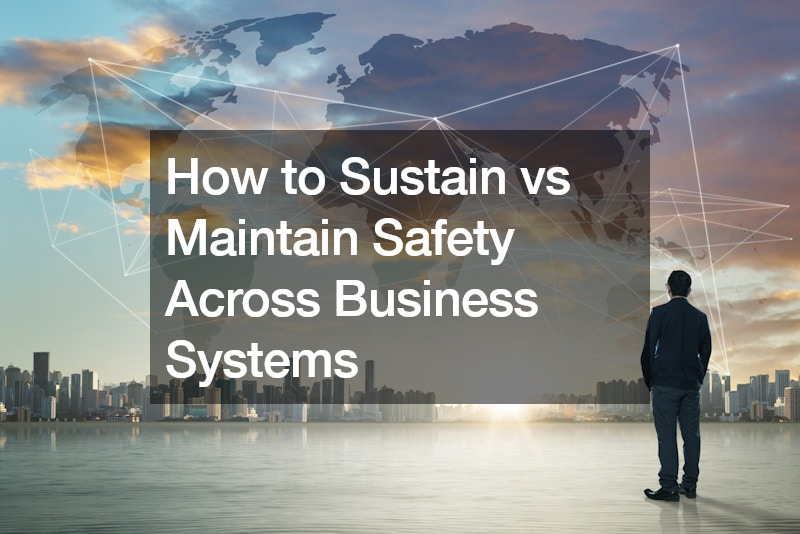This article aims to provide insights on how to effectively sustain and maintain safety across business systems.
1. What is the difference between sustaining and maintaining safety in business systems?

Definition of sustaining safety: Sustaining safety in business systems involves implementing proactive measures to prevent incidents and ensure a safe working environment.
Definition of maintaining safety: Maintaining safety in business systems refers to the ongoing efforts to comply with regulations, conduct inspections, and address any safety issues promptly.
Importance of distinguishing between the two: While maintaining safety focuses on meeting immediate requirements, sustaining safety emphasizes long-term strategies to prevent risks and promote a culture of safety.
2. How can businesses sustain safety across their systems?
Implementing proactive safety measures: Businesses can sustain safety by implementing proactive measures such as regular safety training, hazard assessments, and safety audits.
Continuous monitoring and evaluation: Sustaining safety requires continuous monitoring of safety performance, evaluating the effectiveness of safety measures, and making necessary improvements.
Employee training and engagement: Engaging employees in safety initiatives, providing ongoing training, and encouraging a safety-conscious culture are key to sustaining safety across business systems.
3. What are the key strategies for maintaining safety in business systems?

Regular inspections and audits: Maintaining safety involves conducting regular inspections, audits, and assessments to identify and address potential safety hazards.
Compliance with regulations and standards: Maintaining safety requires compliance with regulations, industry standards, and best practices to ensure a safe working environment.
Incident reporting and investigation: Maintaining safety involves prompt reporting and investigation of safety incidents to identify root causes and prevent future occurrences.
4. How can businesses create a balance between sustaining and maintaining safety?
Integrating sustainability into safety practices: By integrating sustainability principles into safety practices, businesses can create a balance between sustaining and maintaining safety across their systems.
Prioritizing long-term safety goals: Prioritizing long-term safety goals over short-term objectives helps businesses focus on sustaining safety while also maintaining current safety standards.
Encouraging a proactive safety mindset: Encouraging a proactive safety mindset among employees enables businesses to prevent incidents and hazards while also addressing immediate safety concerns.
5. What are the challenges in sustaining safety across business systems?

Resistance to change and complacency: Overcoming resistance to new safety initiatives and addressing complacency among employees can be challenges in sustaining safety across business systems.
Resource constraints and budget limitations: Limited resources and budget constraints may hinder efforts to sustain safety through investments in safety technology, training, and infrastructure.
Resistance to change and complacency: Overcoming resistance to new safety initiatives and addressing complacency among employees can be challenges in sustaining safety across business systems.
Lack of leadership support and buy-in: Without leadership support and buy-in, sustaining safety initiatives may struggle to gain traction and momentum within the organization.
6. How can businesses overcome the challenges of sustaining safety?
Fostering a culture of continuous improvement: By fostering a culture of continuous improvement, businesses can overcome challenges and sustain safety across their systems through ongoing learning and innovation.
Investing in leadership development and communication: Investing in leadership development and effective communication helps ensure that leaders are aligned with safety goals and support sustaining safety efforts.
Engaging employees at all levels in safety initiatives: Engaging employees at all levels in safety initiatives empowers them to actively contribute to sustaining safety and drive positive safety outcomes.
7. What are the potential risks of focusing solely on maintaining safety?
Complacency and stagnation in safety practices: Focusing solely on maintaining safety may lead to complacency among employees and stagnation in safety practices, increasing the risk of incidents.
Increased vulnerability to emerging risks and hazards: Neglecting sustained safety measures can increase vulnerability to emerging risks and hazards that may not be addressed through traditional maintenance practices.
Diminished organizational resilience and agility: Relying solely on maintaining safety may result in diminished organizational resilience and agility in responding to unforeseen safety challenges and disruptions.
8. How can businesses transition from maintaining to sustaining safety?
Conducting a gap analysis of current safety practices: By conducting a gap analysis of current safety practices, businesses can identify areas for improvement and transition towards sustaining safety practices.
Complacency and stagnation in safety practices: Focusing solely on maintaining safety may lead to complacency among employees and stagnation in safety practices, increasing the risk of incidents.
Increased vulnerability to emerging risks and hazards: Neglecting sustained safety measures can increase vulnerability to emerging risks and hazards that may not be addressed through traditional maintenance practices.
Setting clear sustainability goals and objectives: Setting clear sustainability goals and objectives helps businesses align their safety efforts with long-term safety goals and priorities.
Implementing pilot programs to test sustainable practices: Implementing pilot programs to test sustainable safety practices allows businesses to assess their effectiveness before scaling up across the organization.
Resistance to change and complacency: Overcoming resistance to new safety initiatives and addressing complacency among employees can be challenging in sustaining safety across business systems.
9. How can businesses measure the effectiveness of their safety sustainability efforts?
Key performance indicators for safety sustainability: Establishing key performance indicators for safety sustainability helps businesses track progress, measure outcomes, and evaluate the effectiveness of their safety efforts.
Conducting regular safety culture surveys and assessments: Conducting regular safety culture surveys and assessments provides insights into employee perceptions of safety practices and helps identify areas for improvement. This is vital for everything from bathroom trailers to drain cleaning companies and commercial roofer teams.
Tracking safety incident rates and near misses: Tracking safety incident rates and near misses enables businesses to detect trends, take corrective actions, and prevent future incidents.
10. How can businesses sustain safety in times of crisis or disruption?
Developing a crisis management plan with safety as a priority: Developing a crisis management plan that prioritizes safety ensures that businesses are prepared to sustain safety during crises and disruptions.
Establishing clear communication channels and protocols: Establishing clear communication channels and protocols helps ensure efficient and effective communication during crises to sustain safety efforts.
Ensuring business continuity and resilience through redundancies: Ensuring business continuity and resilience through redundancies in critical safety systems helps sustain safety even in challenging situations.
11. How can businesses maintain safety standards in a rapidly changing environment?
Adapting safety protocols to technological advancements: Adapting safety protocols to technological advancements helps businesses stay current and maintain safety standards in a rapidly changing environment.
Staying updated on regulatory changes and industry trends: Staying updated on regulatory changes and industry trends allows businesses to adjust their safety practices to maintain compliance and effectiveness. If you need clogged drain repair services or potentially a sun room company assessment (or even fall arrest systems and maintenance), check this out.
Conducting regular risk assessments and scenario planning: Conducting regular risk assessments and scenario planning enables businesses to identify potential risks and develop strategies to maintain safety standards.
Conducting regular risk assessments and scenario planning: Conducting regular risk assessments and scenario planning enables businesses to identify potential risks and develop strategies to maintain safety standards.
12. How can businesses ensure the sustainability of safety practices in global operations?
Developing a consistent global safety policy and standards: Developing a consistent global safety policy and standards ensures that safety practices are aligned across all global operations. auto body collision repair services are not to be taken lightly. Nor are concrete lifting and stabilizing or a catch basin cleaning service. Look more into this by consulting with local plumbing contractors.
Tailoring safety practices to local regulations and cultural norms: Tailoring safety practices to local regulations and cultural norms helps businesses maintain safety standards while respecting local requirements.
Implementing technology solutions for remote monitoring and communication: Implementing technology solutions for remote monitoring and communication enables businesses to sustain safety practices in global operations effectively.
13. How can businesses integrate sustainability principles into safety management?
Aligning safety goals with environmental and social responsibility: Aligning safety goals with environmental and social responsibility principles allows businesses to integrate sustainability into safety management practices.
Implementing sustainable practices in daily operations: Implementing sustainable practices in daily operations helps businesses reduce their environmental footprint and promote sustainable safety practices.
Measuring carbon footprint and environmental impact of safety initiatives: Measuring carbon footprint and environmental impact of safety initiatives enables businesses to assess the sustainability of their safety practices.
Tailoring safety practices to local regulations and cultural norms: Tailoring safety practices to local regulations and cultural norms helps businesses maintain safety standards while respecting local requirements.
Implementing technology solutions for remote monitoring and communication: Implementing technology solutions for remote monitoring and communication enables businesses to sustain safety practices in global operations effectively.
14. How can businesses build resilience through sustained safety practices?
Integrating safety into strategic risk management processes: Integrating safety into strategic risk management processes helps businesses build resilience and sustain safety practices in the face of uncertainties.
Developing contingency plans for various safety scenarios: Developing contingency plans for various safety scenarios ensures businesses are prepared to respond and sustain safety in the event of emergencies.
Learning from past incidents and near misses for continuous improvement: Learning from past incidents and near misses helps businesses identify areas for improvement and enhance their resilience through sustained safety practices.
15. How can businesses engage employees in sustaining safety across business systems?
Empowering employees to take ownership of safety practices: Empowering employees to take ownership of safety practices fosters a culture of accountability and sustainability in sustaining safety efforts.
Providing ongoing safety training and development opportunities: Providing ongoing safety training and development opportunities equips employees with the knowledge and skills to sustain safety practices effectively.
Recognizing and rewarding safety contributions and achievements: Recognizing and rewarding safety contributions and achievements motivates employees to actively participate in sustaining safety across business systems.
Tailoring safety practices to local regulations and cultural norms: Tailoring safety practices to local regulations and cultural norms helps businesses maintain safety standards while respecting local requirements.
Implementing technology solutions for remote monitoring and communication: Implementing technology solutions for remote monitoring and communication enables businesses to sustain safety practices in global operations effectively.
16. What are the long-term benefits of sustaining safety in business systems?
Improved employee morale, satisfaction, and retention: Sustaining safety in business systems leads to improved employee morale, satisfaction, and retention, creating a positive work environment.
Enhanced organizational reputation and stakeholder trust: Sustaining safety enhances organizational reputation and builds stakeholder trust, contributing to long-term success.
Reduced incidents, accidents, and downtime due to safety failures: By sustaining safety, businesses can reduce incidents, accidents, and downtime caused by safety failures, improving productivity.
17. Conclusion
In conclusion, sustaining safety across business systems requires a proactive and long-term approach that goes beyond traditional maintenance practices. By integrating sustainability principles, engaging employees, and building resilience, businesses can create a culture of safety that not only protects their employees and assets but also contributes to their long-term success and sustainability.





